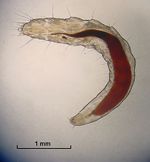Difference between revisions of "Flea Life Cycle"
| Line 2: | Line 2: | ||
A thorough understanding of the flea life-cycle is important in order to be able to advise owners of adequate treatments to control flea infections on their animals and within the home environment. | A thorough understanding of the flea life-cycle is important in order to be able to advise owners of adequate treatments to control flea infections on their animals and within the home environment. | ||
| − | + | The time for the egg to develop into the adult flea takes around '''3-4 weeks''' in summer, however, the duration of the life cycle is largely dependent on the environmental temperature. | |
| − | |||
| − | |||
'''1. Adults''' | '''1. Adults''' | ||
| − | + | Once the adults are on host, the flea will usually remain for its duration. There will be a degree of transfer between hosts, with animals in close contact. | |
| − | |||
| − | |||
| − | |||
| − | |||
| − | |||
| − | |||
| − | + | The adult flea takes frequent blood meals. Around 97% of fleas will feed within 1 hour of finding a host and feed for approximately 10-25 minutes. '''Flea dirt''' (faeces) is produced in large quantities. | |
| − | + | The life span of the flea is determined by the grooming activity of the host. Usually the adult flea lives for '''7 to 10 days''' | |
| − | |||
'''2. Eggs''' | '''2. Eggs''' | ||
Revision as of 13:16, 27 July 2010
A thorough understanding of the flea life-cycle is important in order to be able to advise owners of adequate treatments to control flea infections on their animals and within the home environment.
The time for the egg to develop into the adult flea takes around 3-4 weeks in summer, however, the duration of the life cycle is largely dependent on the environmental temperature.
1. Adults
Once the adults are on host, the flea will usually remain for its duration. There will be a degree of transfer between hosts, with animals in close contact.
The adult flea takes frequent blood meals. Around 97% of fleas will feed within 1 hour of finding a host and feed for approximately 10-25 minutes. Flea dirt (faeces) is produced in large quantities.
The life span of the flea is determined by the grooming activity of the host. Usually the adult flea lives for 7 to 10 days
2. Eggs
- The adult lays eggs 1-2 days after locating a host
- Approximately 15 eggs are layed in the coat per day
- Eggs are ivory white, oval and approxiamtely 0.5mm long
- The eggs drop to the ground within hours
- In reality this usually happens when the animal jumps of the sofa or makes sudden movements. Flea eggs will therefore cluster in these hot spots around the house. These areas should be paid particular attention when treating the environment in the case of a flea infestation.
3. Larvae
- Larvae are small, about 2-5mm in length
- Larvae are yellow/white (look like maggots) and are covered in bristles
- They have chitinous mouthparts and anal struts which can be used for identification
- Larvae are negatively phototropic so try to move away from light sources
- E.g. under furniture, into thick mats or carpet
- Larvae feed on skin debris from other animals, flea dirt and other organic debris
- High humidity is needed for survival
- Freezing temperatures will kill larvae
4. Pupae
- The larvae pupate forming pupae of 5mm in length
- A silken cocoon surrounds the pupae
- Slightly sticky so small particles adhere to it
- These quickly become camouflaged in the environment
- Methoprene, the juvenile development hormone coordinates the growth of the immature stages
- Activates genetic switches
- Determines the sequence of tissue and organ development
- Newly developed adults do not leave the cocoon straight away
- The pupal window is the time that it takes for the adult to emerge
- Temperature determines when the adult fleas emerge
- Some fleas may wait several months before emerging
- Newly emerged unfed adults can survive days without feeding but once they have fed, if they fall off the host they can only survive hours
